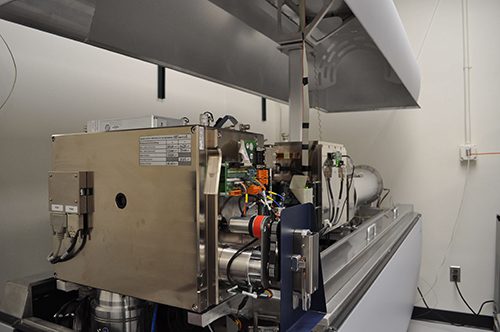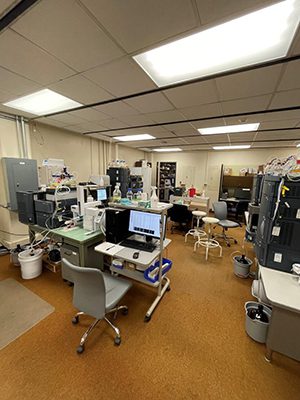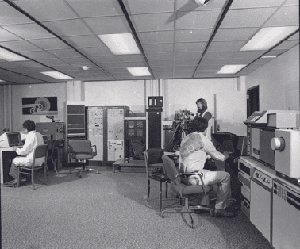Recently, the Mass Spectrometry and Metabolomics Core located in the College of Natural Science’s Department of Biochemistry and Molecular Biology, or BMB, completed nearly $2.2 million in renovations, allowing the facility to tackle even more of chemistry’s toughest analytical questions.
For over 50 years, MSU’s mass spec facility has provided researchers with the cutting-edge instruments and technical expertise necessary to perform small molecule, macromolecule and metabolomic analyses. The latest improvements build upon the facility’s already storied presence as a one-of-a-kind campus resource — a meeting place of research and education that aims to keep pace with the oftentimes dizzying speed of scientific innovation.

“When we think of the revolution that’s occurred in analytical chemistry and mass spectrometry over the past several decades, you might compare it to the leap from Galileo first seeing the moons of Jupiter to what we’re glimpsing through the JWST today,” said Dan Jones, director of the mass spec facility since 2005. Jones, also a professor of biochemistry and molecular biology, was referencing NASA’s newest space telescope mission that’s providing unprecedented views of the cosmos.
“Where once there was a crude way of identifying single chemicals, we can now look far deeper, identifying hundreds or thousands of different chemicals in a single sample.”
The recent renovations represent a full overhaul of 3,400 square feet of laboratory, with an emphasis on improving day-to-day operations.
The renovation funding was provided by MSU’s Office of Research and Innovation. Doug Gage, vice president of the Office of Research and Innovation and a professor of biochemistry and molecular biology, was a previous mass spec facility director who oversaw its significant expansion in the late 1990s and early 2000s.

“We are very pleased to provide the resources for the upgrades to this facility — one which is utilized by so many faculty and students to support their research efforts,” Gage said.
“This has been a total update both mechanically and structurally, so we can accommodate more and newer instruments,” said Anthony “Tony” Schilmiller, assistant director of the facility.
“Many of these updates are ones that visitors might not notice at first glance: nitrogen piping in the ceilings, better HVAC and just a totally improved and updated space.”
The completion of renovations also coincides with the arrival of new instruments allowing researchers to perform imaging using a technique known as MALDI-TOF MS, or matrix-assisted laser desorption/ionization-time of flight mass spectrometry.
“In these experiments, it’s possible to take a tissue section and actually generate mass spectra and positional information as to where metabolites are located,” Schilmiller added. “We think that medical labs will be incredibly interested in this.”
TECHNOLOGY AND TRAINING FOR CAMPUS AND BEYOND
The constant addition of state-of-the-art instruments has made mass spec a longtime draw for dynamic researchers to MSU. Melanie Balbach, an assistant professor who joined BMB in August 2023, saw the mass spec facility as an invaluable asset for her ongoing study of reproductive physiology and sperm metabolism, which have applications for our understanding of infertility and male contraception.
“You can do basic biochemistry anywhere,” Balbach said. “But to have these advanced instruments that need to be maintained carefully, and to have people who are experts on hand — that’s what makes MSU really excellent.”
While the facility’s expert managers and technicians often conduct experiments on its users’ behalf, individuals interested in the technical processes of mass spectrometry can become skilled users themselves.

Doug Allen, a principal investigator at the Donald Danforth Plant Science Center in St. Louis and a former research assistant professor at MSU, remembers his influential experience working and learning in the mass spec facility.
“The mass spectrometry facility was an integral part of my scientific training,” Allen said. “Using isotopes to tease apart metabolic fluxes through biochemical pathways, I was taught skills I continue to rely on and pass on to others in my own lab to this day.”
Xingxing Li, a postdoctoral researcher in Professor Robert Last’slab in BMB, also commended the educational benefits the facility provides.
“The mass spec and metabolomics center is an essential, unique, and irreplaceable part of the MSU research community. Dan Jones, Tony Schilmiller, and research assistants Casey Johnny and Lijun Chen have all helped me become a skilled mass spec user,” Li explained.
“Unlike many facilities at other universities that won’t allow researchers to operate their own machines, MSU’s staff are willing to spend time training users if there’s an interest in learning,” Li said.
“How Professor Jones and others have been running the facility is brilliant, and people like me have gained tremendously from this.”
Mass spec staff have worked closely with faculty and students across departments within the College of Natural Science, but across campus, including researchers in the College of Social Science, the College of Engineering, the College of Agriculture and Natural Resources and more.
These interactions have generated many longstanding partnerships between the mass spec facility and various communities that help fuel breakthroughs.

“The many ways we’ve used mass spec include analytical support for pharmacokinetic studies, metabolism studies, metabolite identification, and analytical support for newly prepared compound characterization,” said Bilal Aleiwi, associate director of the Medicinal Chemistry Core at MSU.
Along with the MSU Drug Discovery Program, the Medicinal Chemistry Core is a key component of a university-wide effort to support life sciences and pharmaceutical development.
“By using these facilities, we’ve established and expanded our collaborations both inside and outside MSU,” Aleiwi said.
Meanwhile, in MSU’s Department of Fisheries and Wildlife, researchers have applied mass spec’s analytical power to a local issue — fighting the spread of destructive sea lampreys in the Great Lakes region. Sonam Tamrakar, a postdoctoral research associate in the lab of Professor Weiming Li, described ongoing breakthroughs in the search for new methods of sea lamprey control.
“The mass spec facility has been a very important part of our sea lamprey pheromone study,” Tamrakar said.
Working with the mass spec facility, the team has studied more metabolites found in different parts of a lamprey’s anatomy. They’ve even discovered bile acid pheromones that are specific to lamprey, Tamrakar said.
“Moreover, the training and technical support provided by staff have helped us develop improved analytical methods and test new ideas to answer our research questions,” Tamrakar added.
With its latest renovations complete, the mass spec facility is excited to next develop its computational potential. Using the latest bioinformatic software and dedicated experts, the facility is working to enable researchers to extract even deeper insights from the huge amounts of data they produce.
“Technologies are always emerging that can do the job faster, better, and more efficiently,” Jones said. “We’re seeing much deeper now, and the more we learn about what’s out there, the more we learn about why it’s important. That’s why our task is to ultimately keep our facilities up to date and to always be looking ahead.”
This story first published by the MSU College of Natural Science
